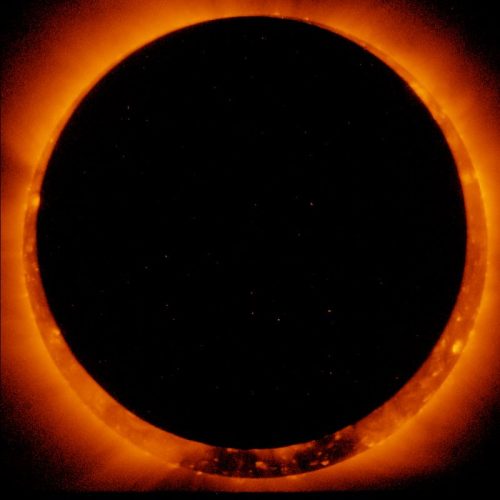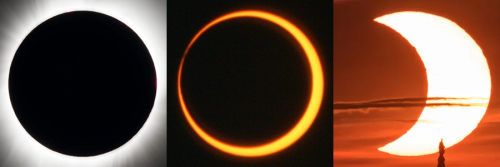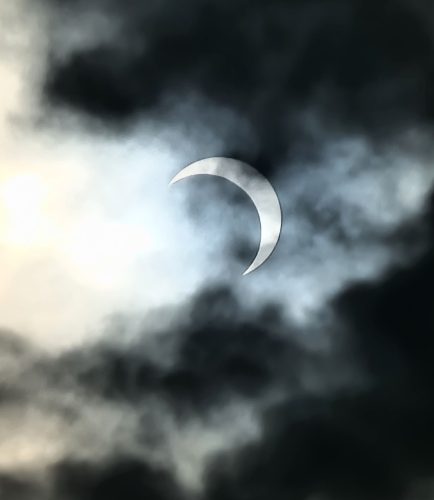
Lauren Perkins, NASA Marshall Space Flight Center, NASA Blog Coming Soon: A “Ring of Fire” in the Sky
On Oct. 14, 2023, an annular total solar eclipse will be visible to millions across the globe as it sweeps through the skies of the northwestern United States through Mexico and Central America and into South America, exiting the continent in Brazil. Even if you are not in the path of annularity, you will still be able to see a partial solar eclipse if weather conditions are right. [Warning: During an annular eclipse, it is never safe to look directly at the Sun without specialized eye protection designed for solar viewing.]
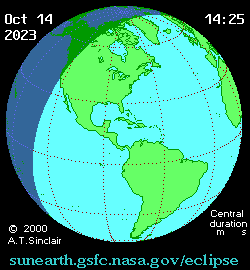
A map developed using data from a variety of NASA sources shows a detailed eclipse path and what observers across the States can expect to see at their local time.
The Moon’s distance from Earth is not constant, sometimes it is a little closer, sometimes a little farther away. When the Moon passes between the Sun and Earth while it is close to or at its farthest point from Earth, an annular eclipse happens. Because the Moon is farther away from Earth than on average, it appears smaller than the Sun, creating a “ring of fire” effect in the sky, and since the Sun is never completely covered, observers must wear proper eye protection at all times while watching an annular eclipse.
During a total solar eclipse, like the upcoming 2024 Solar Eclipse, the Moon is close enough to Earth to be sufficiently large to completely cover the bright face of the Sun. During the few minutes of totality, there will be darkness around midday.
What you can see during an annular eclipse depends on the weather and your location.
First, you need a clear sky to see the eclipse. However, even with cloud cover, the eerie daytime darkness associated with eclipses is still noticeable to human animals as well as the four-footed ones and the flying ones. Birds go to roost, bees return to the hive, and even turtles come out of ponds.
Second, to see all phases of an annular eclipse, including the “ring of fire,” you must view it from somewhere within the path of annularity.
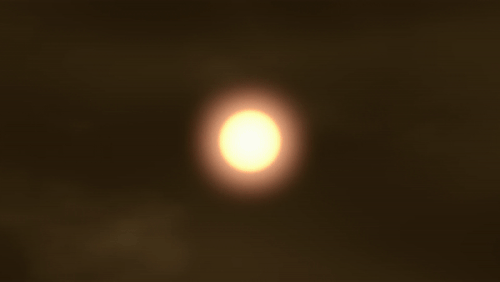
If you are not within the path of annularity, watching the eclipse from a virtual location is a great option. Join NASA for conversations with scientists and telescope views from across the country on NASA’s YouTube beginning at 10:30 a.m. CT on Oct. 14, 2023.
https://www.youtube.com/watch?v=LlY79zjud-Q
The Solar Eclipse Experience
On Oct. 14, 2023, and April 8, 2024, the entire United States and millions around the world will be able to view a solar eclipse.
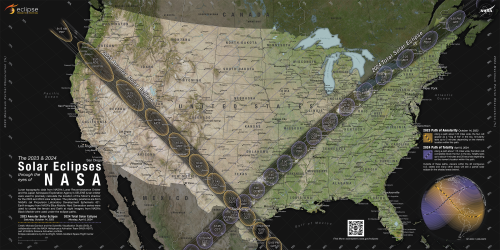
There are three different kinds of solar eclipses: total, annular, and partial. When the Moon is far from the Earth, its size is too small to completely cover the Sun, thus an annular eclipse is observed, like what is expected on Oct. 14, 2023. When the Moon is close to the Earth, its larger size completely covers the Sun, causing a total eclipse, which will occur on April 8, 2024. A partial eclipse occurs when the Earth, Moon, and Sun are not perfectly aligned so only a part of the Sun will appear to be covered, giving it a crescent shape. During a total or annular solar eclipse, people outside the totality/annularity paths will see a partial solar eclipse.
From left to right, this image shows a total solar eclipse, annular solar eclipse, and partial solar eclipse.
The Eclipse Experience
Mitzi Adams, NASA Marshall Space Flight Center Heliophysics and Planetary Science Branch Assistant Chief, shares her observations during the five total eclipses she has experienced. “It is like nothing you’ve ever experienced before. It’s sort of like somebody puts a bowl on top of Earth right above where you’re standing. In the middle of the day, it gets darker, but you can still see light around the rim.” Adams explains. “You can essentially observe a sunrise or sunset. The temperatures cool. The wind picks up. The birds may go to roost, or the coyotes may howl.”
During an annular eclipse like the one coming up on Oct. 14, even with the sun covered up to 90%, the sky remains fairly bright. Those in the path of annularity will have a chance to observe the famed “ring of fire” effect, but it is important to manage your expectations and to remember that solar viewing glasses will be needed during the event’s entirety.
Bill Cooke, NASA’s Meteoroid Environment Office Lead and eclipse enthusiast, says he is most looking forward to the 2024 total eclipse because totality, when the sun is covered 100%, will last much longer than the last total eclipse in 2017 – up to nearly four and a half minutes.
In any of the upcoming eclipse events, in our technology-fueled world, you may also experience some electronic changes as the moon moves across Earth and the ionosphere cools.
The ionosphere forms the boundary between the Earth’s lower atmosphere – where we live and breathe – and the vacuum of space. It is formed when particles are charged, or ionized, by solar radiation. A total solar eclipse effectively “turns off” the ionosphere’s primary charging mechanism, mimicking nighttime conditions, so the many communications signals passing through the ionosphere could be disrupted.
GPS signals could produce location errors. Radio waves could change, sometimes even allowing Ham Radio operators to send or receive transmissions over longer distances.
The ionosphere is also home to many NASA satellites, including the International Space Station.
Solar Eclipse Science
Experiencing an eclipse is one way that everyone can participate in NASA Science. Depending on your access to different types of technology (phones, laptops, telescopes), there are several NASA Citizen Science projects you can participate in that relate to the Sun’s corona and the effects of the Moon’s shadow on Earth’s upper atmosphere.
GLOBE Observer https://observer.globe.gov/do-globe-observer
Help monitor the conditions of clouds, water (especially as a habitat for mosquitoes), plants (trees and other land cover), and see change over time.
Solar Jet Hunter https://www.zooniverse.org/projects/sophiemu/solar-jet-hunter
Join the hunt for solar jets — enigmatic bursts of energy from our own star — the Sun!
Planet Hunters Transiting Exoplanet Survey Satellite (TESS) https://www.zooniverse.org/projects/nora-dot-eisner/planet-hunters-tess Find planets that will help us understand how these extrasolar systems form and evolve over time.
Eclipse Soundscapes https://eclipsesoundscapes.org/
Provide multi-sensory observations and recorded sound data to study how solar eclipses affect life on Earth!
HamSCI https://hamsci.org/ Advance scientific research and understanding through amateur radio activities.
Radio JOVE: https://radiojove.gsfc.nasa.gov/ Observe and analyze natural radio emissions of Jupiter, the Sun, and our galaxy using their own easy to construct radio telescopes.
Sungrazer Project https://sungrazer.nrl.navy.mil/
Become a “Comet Hunter”, and immediately begin looking for new comets in the spacecraft data.
Regardless of how you plan to experience a solar eclipse, or any solar viewing for that matter, remember to always do so safely. https://solarsystem.nasa.gov/eclipses/safety/
Lauren Perkins
NASA Marshall Space Flight Center

